PROVENCE
Plants and Animals

Plants and Animals
Popular destinations FRANCE
| Alsace | Ardeche | Auvergne |
| Brittany | Burgundy | Cevennes |
| Corsica | Cote d'azur | Dordogne |
| Jura | Languedoc-roussillon | Loire valley |
| Lot | Normandy | Picardy |
| Provence |
Plants and Animals
Plants
Due to the differences in climate and soil composition, there are totally different forms of plant and animal life in Provence. Human intervention has also had an impact on the flora and fauna in this area.
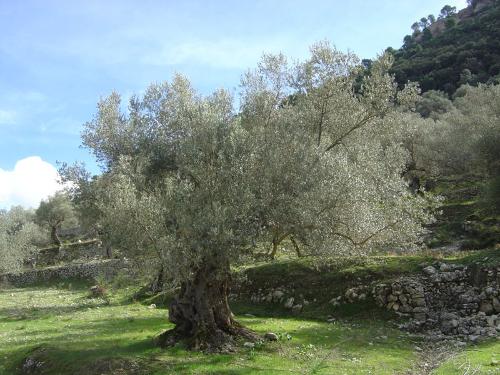 Olive trees ProvencePhoto: David Brühlmeier CC 3.0 no changes made
Olive trees ProvencePhoto: David Brühlmeier CC 3.0 no changes made
A good example of the latter are the olive trees that are so characteristic of Provence, which were introduced by the Greeks around 500 BC. The sometimes centuries-old olive trees can be found up to 600 metres above sea level. There are different types of olives, such as the tanche, the olive de Baux or salonesquw, the aglandau, the grossanne and the picholine. Other examples of human intervention are the almond tree from Asia, the cedars from Morocco, the orange tree, the lemon tree, the palm, and the eucalyptus and mimosa from Australia.
The most typical Provençal tree is the cypress, which can reach a height of 30 metres and which grows solitary or in hedges. The plane tree with its peeling bark is also a native tree species, as well as the "micocoulier", a southern French elm species.
Other common tree species are stone pine, maritime pine, Aleppo pine, sweet chestnut, fig tree, lotus tree, cork oak, spruce and larch.
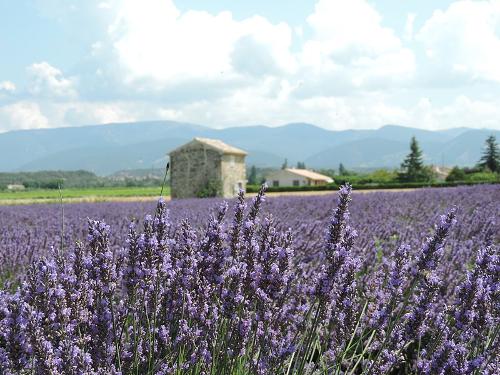 Lavender ProvencePhoto: Dmytro Ivashchenko CC 4.0 no changes made
Lavender ProvencePhoto: Dmytro Ivashchenko CC 4.0 no changes made
Typical Provençal flora can be found on the 'giant of Provence', Mont Ventoux. Due to the temperature difference between the foot of the mountain and the top, 11°C, the vegetation varies enormously. Lavender and plum trees at the foot of the mountain, oak, beech and Lebanon cedars on the slopes, to arctic flowers around the summit, including wormwood, fenugreek, male orchid, Greenland poppy, Turk's cap lily, cross thistle, sand thistle, alpine poppy, Icelandic poppy, Rhaetian poppy and spring gentian. In total, more than 400 flower species grow on Mont Ventoux.
West of the Marseille-Salon-Avignon line, from an altitude of 200 metres, there is a garrigue landscape, chalk mounds scorched by the sun. There are different types of garrigue. Some are in the form of open woods, others are scrubland areas and yet others are known as 'leopard skin areas', where the vegetation consists of grassy patches on stony ground.
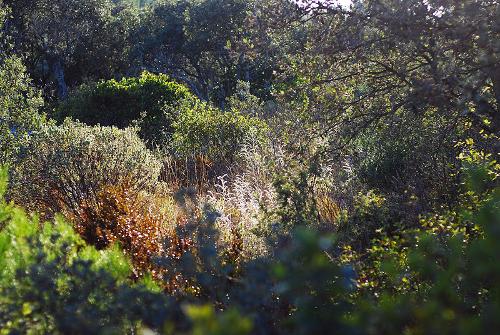 Garrigue PtovencePhoto: Piriou CC 2.0 no changes made
Garrigue PtovencePhoto: Piriou CC 2.0 no changes made
Typical trees for the garrigue are the holm oak and the kermes oak, which resembles holly and can reach up to two metres in height. Under these trees grow well-known herbs such as thyme, rosemary, gorse, lavender, juniper, spurge and some grasses. In this ecosystem, with a severe lack of water, native reptiles such as the couleuvre (field snake) and the pearl lizard thrive. The limestone Plateau de Vaucluse is characterised by the "maquis", a rough plain with, among others, kermes oak, broom, thistle species, many types of climbing plants and gorse.
In the higher parts of the coast, a cushion-like vegetation grows, which also includes the "astragale de Marseille". In the summits of the UNESCO biosphere reserve, the Parc Naturel Régional du Lubéron, rare plant species such as the purple orchid, the large ephedra, the rockrose and the Etruscan honeysuckle grow. Saxifraga florentula, a representative of the stonecrop family, is one of the most remarkable plants found in the Parc National du Mercantour. It does not occur anywhere else in Europe.
Animals
Large wild mammals are rare in Provence, with the exception of wild boar. Small predators such as polecat, badger, weasel, fox, stone marten and genet are common. Released beavers have survived well in the Rhone. The smallest mammal in the world is also found in these parts: the 3-5 cm long eyelash shrew. On the rocky bottom of the Crau live merino sheep, grey donkeys and Rove goats.
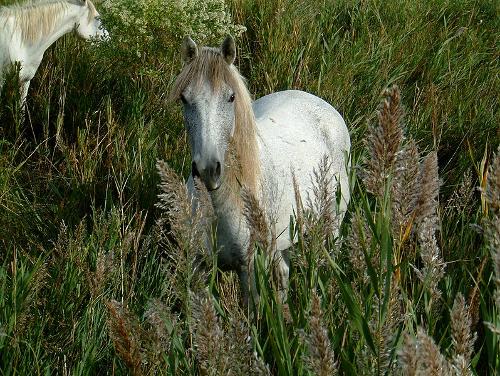 White Camargue horse in the ProvencePhoto: Hedwig Storch in the pubic domain
White Camargue horse in the ProvencePhoto: Hedwig Storch in the pubic domain
In the Camargue live the black Camargue bull, the white Camargue horse (approx. 80,000 head), wild boar, coypu and marsh beavers. The more than 100,000 swamp beavers are a serious threat to the Camargue dykes. The Parc National du Mercantour (approx. 70,000 ha) is home to, among others, the Italian wolf, marmots, chamois, ibex, wild boar, ermine and mouflon. The Provencal donkey was officially recognised as a breed in 1995.
Reptiles such as turtles (among others, the rare Hermann's turtle in the Massif des Maures), snakes (among others, the longest snake in Europe, the field snake (2m), viper's snake and the protected pointed snake), hazelworms, geckos, lizards (especially the largest lizard in Europe, the spotted lizard and the green lizard) are well represented as well as amphibians such as frogs, salamanders (among others, spotted fire salamanders) and the lizards of the mountains. and insects such as butterflies, beetles, praying mantises and the famous song cicada with its sound so characteristic of Provence.
It is remarkable that in a watery area such as the Camargue, few reptiles and amphibians live other than salamanders, frogs and marsh turtles. On the dry, saline grounds, special species such as the ore-dressing worm, the ladder snake and the Girondine slippery snake survive well.
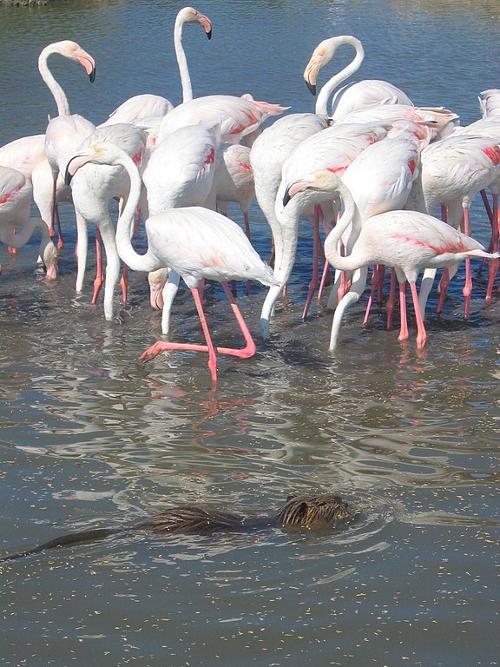 Pink flamingo's in the CamarguePhoto: Jez Atkinson CC 2.0 nochanges made
Pink flamingo's in the CamarguePhoto: Jez Atkinson CC 2.0 nochanges made
Although many songbirds are becoming rare on restaurant menus, there are still many other birds in Provence, especially in the Camargue (approx. 360 species), such as pink flamingo (approx. 10. 000 pairs) magpie, jay, goshawk, barn owl, long-legged owl, nightjar, little egret, dunlin gull (breeds nowhere else in France), white-eyed gull, marsh harrier, fork-tailed plover, stilt, bittern, the rare crowned duck and even the snake eagle. Furthermore, common and egrets, terns, gulls, seagulls and the pink flamingo. On the cliffs of the Calanques live owls, blue blackbirds and swifts. The Plaine de la Crau is home to the rare spiny-tailed hen and the equally rare yellow-billed cuckoo on the Îles d'Hyères. The Crau is also the only breeding place in France for the white-bellied sand grouse and the kestrel. Some other bird species make up about 40% of the French population of the Crau: the little goose, the stone curlew, the calander lark and the red partridge.
The Parc National du Mercantour is home to a large number of birds of prey, such as the royal eagle, the hawk eagle, the snake eagle and the bearded vulture, which was reintroduced in 1993.
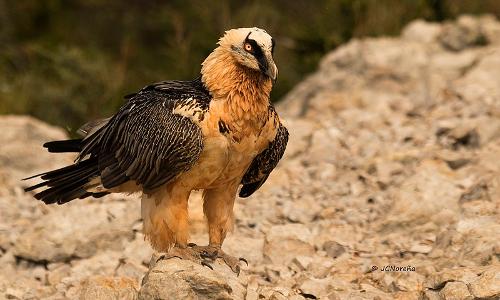 Bearded Vulture, ProvencePhoto: Juan Carlos Noreña CC 4.0 no changes made
Bearded Vulture, ProvencePhoto: Juan Carlos Noreña CC 4.0 no changes made
The Parc Naturel Régional du Lubéron has a very varied fauna with special animals such as the sandhill crane (a kind of lizard), warbler, blue rock thrush and eagle owl.
Rivers and mountain streams are home to countless species of fish, the most important of which is the trout. Eels, bleak, carp, roach, barbel, currant. Along the coast live echinoderms such as sea urchins, starfish, starfish and sea cucumbers, crustaceans and shellfish such as crabs, shrimps, oysters, mussels, crawfish, sea lobsters and lobsters, cave animals such as jellyfish, sea anemones and coral animals, cephalopod molluscs such as octopus, cuttlefish and squid.
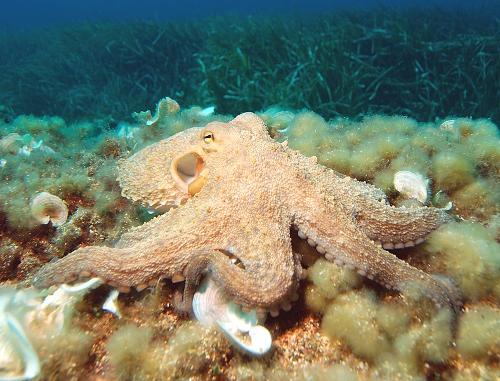 Octopus ProvencePhoto: Albert Kok CC 2.5 no changes made
Octopus ProvencePhoto: Albert Kok CC 2.5 no changes made
The sea is also home to dogfish, catfish, catfish, swampfish, wrasse, pointed cockle, sea spider, bag pipe, squid, sheepshead, mullet, goby, eel, scorpion fish, haddock, grouper, tuna, jellyfish, barbel, sole, mullet, conger eel, gurnard, ray, dab, gilthead seabream and bonito.
Port-Cros, one of the Îles d'Hyères, has been a National Park since 1963, in order to protect the forests, the rare birds and the special marine life. Around the island, the sea is home to Dalmatian sponge, Neptune grass, black goby, marsh eel, common octopus, monkfish, mullet, cardinal perch and tri-finned hagfish, among others.
On the uninhabited Îles de Marseillaveyre, off the coast of Marseille, nest Kuhls shearwaters, petrels, sialas and seagulls. The marine fauna here includes conger eels, chromis, anthias, diplodus, capelin, marsh eels and grouper.
The watery Camargue has about 50 fish species. In fresh water, carp, eel and zander can be found. In brackish water, pipefish and seahorses can be found and the connections between the lakes and the sea are populated by e.g. tadpole, shad, great pipefish, red mullet and turbot.
Sources
Blisse, M. / Provence
Lannoo
Eck, N. van / Provence, Côte d’Azur
Gottmer/Becht
Guérin, R. / Provence
Van Reemst
Jardinaud, M. / Provence
ANWB
Provence
Lannoo,
Williams, R. / Provence & Côte d’Azur
Van Reemst
Zwijnenburg, H. / Provence, Côte d’Azur
ANWB
CIA - World Factbook
BBC - Country Profiles
Copyright: Team The World of Info